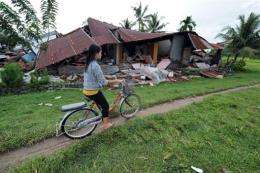New Sumatra quake takes seismologists by surprise

The huge earthquake that hit Sumatra occurred at a deep, unexpected location, illustrating the dangerously complex geological mosaic in this area, a seismologist told AFP on Thursday.
The 7.6 magnitude quake struck on Wednesday 80 kilometers (50 miles) beneath the sea, 45 kilometers northwest of the city of Padang, according to US Geological Survey (USGS) data.
The fault line where this happened runs parallel to Sumatra and is called the Sunda Trench.
It marks a "subduction" zone, where one plate of Earth's crust rides on top of the other.
To the west is the Australia plate, which is moving northeast at about five centimetres (two inches) a year).
The Australia plate is being forced under, or subducted, by the Sunda plate, which lies to the east.
Scientists had long feared a major earthquake would occur on the part of the trench near Padang.
They considered it vulnerable to a so-called quake "cascade" that began with the notorious 9.1 quake of December 26, 2004 that unleashed the Indian Ocean tsunami.
"Cascade" events can occur in long, badly-stressed faults. The stress of a large earthquake causes the next section of a fault to weaken and then rupture, in a domino-like effect.
But Sandy Steacy, a professor at the Environmental Sciences Research Institute at the University of Ulster in Northern Ireland, said Wednesday's quake was not part of this chain reaction.
"The event yesterday was kind of strange, it wasn't what we would have expected," she said.
"It appears if the most recent earthquake didn't occur on the interface of the subduction zone. It occurred within the plate that is being subducted, the part that's going down beneath the interface."
Steacy said that seismologists were working hard to calculate what had happened, but her bet was that the quake had occurred deep below the seabed on the tongue of the Australian plate, contorting as it was forced under the Sunda plate.
"Clearly you are going to get faults in that kind of situation, because you're taking a slab, you're bending it, you're pushing it down, so you're going to get material breakage there," she said.
"I think once calculations are done, they will show that the stress had increased along that structure," she said.
"I suspect that structure, nobody even knew it was there. We don't have any way of mapping the faults in the subducting slab because it's so deep. It's only by having earthquakes on it that gives you an indication."
French expert Robin Lacassin, of the Institute of the Physics of the Globe in Paris, agreed that an "as-yet unknown mechanism" had unleashed Wednesday's quake.
"It happened at some depth, around 80 kilometres. It appears to have occurred in the subducted plate, beneath the face where the two plates meet," he said.
(c) 2009 AFP















